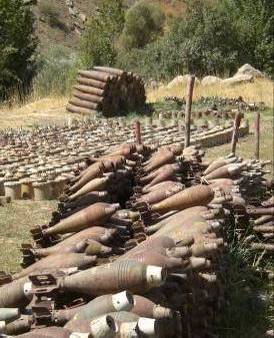Improperly stored and inadequately managed stockpiles of SALW present many security problems and challenges which threaten individuals and societies.
The words of the former UN Secretary-General, Kofi Anan, are still true: ‘Small arms and light weapons are the weapons of mass destruction of the 21st century’. And the Archbishop Desmond Tutu has described the small arms trade in Africa as 'the modern day slave trade which is out of control.’
The fact that - according to figures from Small Arms Survey – armed violence claims at least 740.000 lives per year, of which the vast majority – at least 490.000 – of these occur in non conflict settings, provides sad evidence of these truths.
However, due to the inert characteristics of SALW, large and poorly managed stockpiles do present the catastrophic safety concerns to the public as do large stockpiles of poorly managed ammunition.
The potential threat of SALW is only realized when a live ammunition round is chambered in the weapon. Proper physical security can lessen the likelihood of a SALW becoming that weapon of mass destruction, however poor stockpile management of the SALW can present a fatal safety concern to the individual weapons handler or issued user of the weapon.
Inadequately stored and maintained SALW can present danger to the soldier or policeman eventually issued this item as it may be non-functional or could critically misfire at a time needed most.
SALW as global threat for societies
It is an understatement to say that excessively large stockpiles of poorly secured and maintained SALW present a global security concern. The widespread presence and easy availability of these weapons present a significant threat to human security, a hindrance in the fight against crime and corruption and an obstacle to better social policy and economic development. The same SALW that was procured to defend a national populace and promote national stability, left poorly secured and maintained, can be the cause of violence, conflict and instability in that very same nation.
Even with the cessation of hostilities in a country, the effects caused by unsecured weapons can persist in the area, as does the potential circulation of these weapons across borders and regions. In fact, once these weapons leave government stockpiles they may continue to cause civilian injuries and deaths, constrain social and economic development, enhance criminal capabilities, and contribute to social and ethnic tensions for decades to come.
Recognizing, the dangers that excessive and destabilizing stockpiles of SALW and their potential uncontrolled spread present, nations, regional organizations, and multinational organizations have made varying levels of commitments to address this problem and provide several mechanisms to assist in managing and securing stockpiles.
At the regional and multinational levels, the international community has developed a host of tools and procedures to assist individual nations in the life-cycle of SALW, to include (but not limited to) guidance on manufacturing, proper marking and tracing, accurate and sustained record keeping, export control criteria, transfer transparency, physical security and storage, and destruction and disablement.
Principles for the handling of SALW
MSAG primary concern with regards to SALW is to provide PSSM assistance to requesting nations. As apolitical members of a multinational organization, the MSAG generally uses approved regional and multinational standards on SALW security and management rather than individual national standards when conducting assistance missions.
As a general framework to provide assistance and recommendations, the MSAG has adopted the OSCE’s “Handbook of Best Practices on Small Arms and Light Weapons” and more specifically, Chapter 3, “Best Practice Guide on National Procedures for Stockpile Management and Security” as the practical standard when providing assistance.


